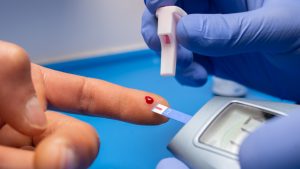Did you know that your skin also plays an important role in blood sugar control?
That’s right, and sunburns can negatively affect glucose levels, especially in people with type 2 diabetes. In this post, we will explain how this relationship works, give you some tips to protect yourself from the sun and take care of your health, and offer you additional information about studies, statistics, and other related resources.

How sunburns affect blood sugar
Sunburns are an inflammatory response of the body to excessive exposure to ultraviolet (UV) rays from the sun. This inflammation releases hormones such as cortisol and prostaglandins, which can increase insulin resistance.
Insulin is a hormone that helps the body use glucose (sugar) as an energy source. When there is insulin resistance, the body cannot use glucose efficiently, which can lead to an increase in blood sugar levels.
Studies supporting this relationship
A study published in the journal Diabetes Care found that people with type 2 diabetes who had sunburns had a higher risk of having high blood sugar levels in the next 24 hours.
Another study, published in The Journal of Clinical Endocrinology & Metabolism, found that sunburns can increase insulin resistance in people with type 2 diabetes.
Relevant statistics
- Type 2 diabetes is the most common form of diabetes, affecting more than 400 million people worldwide.
- People with type 2 diabetes are at increased risk of developing diabetes-related complications, such as heart, kidney, and eye disease.
- Sunburn is one of the most common causes of skin cancer.
What can you do to protect yourself?
1. Use sunscreen:
It is essential to use a broad-spectrum sunscreen with an SPF of 30 or higher every day, even on cloudy days. Apply it generously to all exposed areas of skin 30 minutes before going out in the sun and reapply every two hours, or more often if you sweat or swim.
2. Cover your skin:
Wear protective clothing such as wide-brimmed hats, sunglasses, and long-sleeved shirts to cover as much skin as possible.
3. Avoid the sun during peak hours:
The intensity of UV rays is highest between 10 am and 4 pm. If possible, try to avoid direct exposure to the sun during these hours.
4. Stay hydrated:
Drinking plenty of water helps keep your skin hydrated and reduces the risk of sunburn.
5. Monitor your blood sugar levels:
It is important to monitor your blood sugar levels more often after sun exposure, especially if you have type 2 diabetes.
6. Choose the right sunscreen:
Look for a sunscreen that is:
- Broad-spectrum, which means it protects against UVA and UVB rays.
- With an SPF of 30 or higher.
- Water resistant, if you will be swimming or sweating.
- Fragrance-free and paraben-free, if you have sensitive skin.
7. Consult your doctor:
Your doctor or diabetes educator can help you choose the right sunscreen for you and give you personalized recommendations for sun protection.
Other resources
- American Diabetes Association: https://diabetes.org/
- Centers for Disease Control and Prevention: https://www.cdc.gov/
- Diabetes Research Foundation: https://diabetesresearch.org/
E4 Helps you:
E4 Diabetes Solutions offers an innovative continuous glucose monitoring system (CGM) and a comprehensive program called E4 Alive, designed to empower people with type 2 diabetes to take control of their health.
E4 Alive provides a combination of tools and personalized support to help you:
- Better understand your glucose levels: The E4 CGM system provides accurate, real-time data about your glucose levels, allowing you to identify patterns and make informed decisions about your diet and lifestyle.
- Manage your diet: E4 Alive offers resources and tools to help you create a healthy eating plan tailored to your individual needs.
- Embrace an active lifestyle: The E4 Alive program motivates and supports you in incorporating regular physical activity into your daily routine.
- Connect with a community: E4 Alive provides access to a community of people with type 2 diabetes who share experiences and offer mutual support.
By joining E4 Alive, individuals with type 2 diabetes can:
- Reduce their blood glucose levels
- Improve their long-term glycemic control
- Lower their risk of diabetes-related complications
- Enhance their overall quality of life
E4 Alive is an opportunity for those with type 2 diabetes to take charge of their health and live a fuller life.
To learn more about E4 Diabetes Solutions and the E4 Alive program, visit THIS PAGE.

Type 2 Diabetes: Is It Really Reversible?
A recent National Geographic article [link] explores how type 2 diabetes could be reversible with the right approaches. This condition, which affects millions of people worldwide, has long been considered a chronic and progressive disease. However, recent research challenges this perception and suggests that with lifestyle changes and the right approach, remission is possible. The

How Do GLP-1 Drugs Compare? A Breakdown of Ozempic, Mounjaro, and Trulicity
GLP-1 receptor agonists have revolutionized diabetes management, with drugs like Ozempic, Mounjaro, and Trulicity leading the market. But how do these medications compare in terms of effectiveness, side effects, and patient outcomes? Let’s explore their differences and what they mean for diabetes patients. Understanding GLP-1 Medications GLP-1 receptor agonists mimic a natural hormone that helps

Why Has Medicare Spending on Diabetes Medications Skyrocketed in 5 Years?
In the past five years, Medicare spending on diabetes medications has increased nearly fivefold, reaching $35.8 billion in 2023. This surge has been primarily driven by the growing use of GLP-1 drugs such as Ozempic, Mounjaro, and Trulicity. But what is behind this cost escalation, and how does it affect patients and the U.S. healthcare

The Gut Microbiota and Blood Sugar Control: A Hidden Connection
The human gut is home to trillions of bacteria that play a crucial role in digestion, immune function, and even metabolism. Recent research has revealed a fascinating link between the gut microbiota and blood sugar regulation, shedding light on how the balance of microbes in our intestines can influence diabetes risk and overall metabolic health.

The Dawn Phenomenon: Why Blood Sugar Rises While You Sleep
For many people with diabetes, waking up with high blood sugar levels can be frustrating—especially if they didn’t eat anything overnight. This early-morning spike in blood glucose is known as the Dawn Phenomenon, and it happens due to natural hormonal changes in the body. But why does it occur, and how can it be managed?

The Influence of Red Light on Blood: Can It Improve Diabetes?
Type 2 diabetes is a metabolic disease characterized by insulin resistance and elevated blood glucose levels. In the search for complementary alternatives to improve glycemic control, red light therapy has gained attention due to its potential to enhance circulation, reduce inflammation, and optimize cellular function. But what does science say about it? ✨ What is

